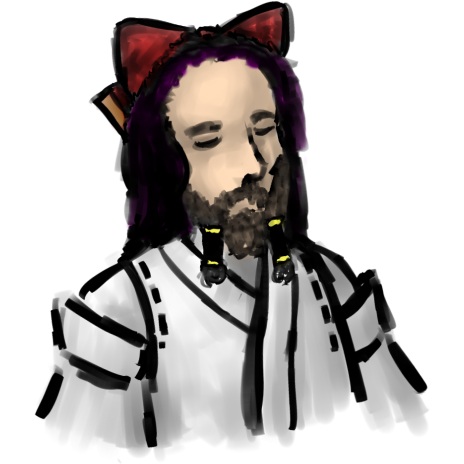- 📝 Posted:
- 🚚 Summary of:
- P0149, P0150, P0151, P0152
- ⌨ Commits:
e1a26bb...05e4c4a,05e4c4a...768251d,768251d...4d24ca5,4d24ca5...81fc861- 💰 Funded by:
- Blue Bolt, Ember2528, -Tom-, [Anonymous]
- 🏷 Tags:
…or maybe not that soon, as it would have only wasted time to untangle the bullet update commits from the rest of the progress. So, here's all the bullet spawning code in TH04 and TH05 instead. I hope you're ready for this, there's a lot to talk about!
(For the sake of readability, "bullets" in this blog post refers to the
white 8×8 pellets
and all 16×16 bullets loaded from
MIKO16.BFT, nothing else.)
But first, what was going on
📝 in 2020? Spent 4 pushes on the basic types
and constants back then, still ended up confusing a couple of things, and
even getting some wrong. Like how TH05's "bullet slowdown" flag actually
always prevents slowdown and fires bullets at a constant speed
instead. ![]() Or how "random spread" is not the
best term to describe that unused bullet group type in TH04.
Or how "random spread" is not the
best term to describe that unused bullet group type in TH04.
Or that there are two distinct ways of clearing all bullets on screen,
which deserve different names:
Bullets are zapped at the end of most midboss and boss phases, and
cleared everywhere else – most notably, during bombs, when losing a
life, or as rewards for extends or a maximized Dream bonus. The
Bonus!! points awarded for zapping bullets are calculated iteratively,
so it's not trivial to give an exact formula for these. For a small number
𝑛 of bullets, it would exactly be 5𝑛³ - 10𝑛² + 15𝑛
points – or, using uth05win's (correct) recursive definition,
Bonus(𝑛) = Bonus(𝑛-1) + 15𝑛² - 5𝑛 + 10.
However, one of the internal step variables is capped at a different number
of points for each difficulty (and game), after which the points only
increase linearly. Hence, "semi-exponential".
On to TH04's bullet spawn code then, because that one can at least be decompiled. And immediately, we have to deal with a pointless distinction between regular bullets, with either a decelerating or constant velocity, and special bullets, with preset velocity changes during their lifetime. That preset has to be set somewhere, so why have separate functions? In TH04, this separation continues even down to the lowest level of functions, where values are written into the global bullet array. TH05 merges those two functions into one, but then goes too far and uses self-modifying code to save a grand total of two local variables… Luckily, the rest of its actual code is identical to TH04.
Most of the complexity in bullet spawning comes from the (thankfully
shared) helper function that calculates the velocities of the individual
bullets within a group. Both games handle each group type via a large
switch statement, which is where TH04 shows off another Turbo
C++ 4.0 optimization: If the range of case values is too
sparse to be meaningfully expressed in a jump table, it usually generates a
linear search through a second value table. But with the -G
command-line option, it instead generates branching code for a binary
search through the set of cases. 𝑂(log 𝑛) as the worst case for a
switch statement in a C++ compiler from 1994… that's so cool.
But still, why are the values in TH04's group type enum all
over the place to begin with? ![]()
Unfortunately, this optimization is pretty rare in PC-98 Touhou. It only
shows up here and in a few places in TH02, compared to at least 50
switch value tables.
In all of its micro-optimized pointlessness, TH05's undecompilable version
at least fixes some of TH04's redundancy. While it's still not even
optimal, it's at least a decently written piece of ASM…
if you take the time to understand what's going on there, because it
certainly took quite a bit of that to verify that all of the things which
looked like bugs or quirks were in fact correct. And that's how the code
for this function ended up with 35% comments and blank lines before I could
confidently call it "reverse-engineered"…
Oh well, at least it finally fixes a correctness issue from TH01 and TH04,
where an invalid bullet group type would fill all remaining slots in the
bullet array with identical versions of the first bullet.
Something that both games also share in these functions is an over-reliance
on globals for return values or other local state. The most ridiculous
example here: Tuning the speed of a bullet based on rank actually mutates
the global bullet template… which ZUN then works around by adding a wrapper
function around both regular and special bullet spawning, which saves the
base speed before executing that function, and restores it afterward.
![]() Add another set of wrappers to bypass that exact
tuning, and you've expanded your nice 1-function interface to 4 functions.
Oh, and did I mention that TH04 pointlessly duplicates the first set of
wrapper functions for 3 of the 4 difficulties, which can't even be
explained with "debugging reasons"? That's 10 functions then… and probably
explains why I've procrastinated this feature for so long.
Add another set of wrappers to bypass that exact
tuning, and you've expanded your nice 1-function interface to 4 functions.
Oh, and did I mention that TH04 pointlessly duplicates the first set of
wrapper functions for 3 of the 4 difficulties, which can't even be
explained with "debugging reasons"? That's 10 functions then… and probably
explains why I've procrastinated this feature for so long.
At this point, I also finally stopped decompiling ZUN's original ASM just
for the sake of it. All these small TH05 functions would look horribly
unidiomatic, are identical to their decompiled TH04 counterparts anyway,
except for some unique constant… and, in the case of TH05's rank-based
speed tuning function, actually become undecompilable as soon as we
want to return a C++ class to preserve the semantic meaning of the return
value. Mainly, this is because Turbo C++ does not allow register
pseudo-variables like _AX or _AL to be cast into
class types, even if their size matches. Decompiling that function would
have therefore lowered the quality of the rest of the decompiled code, in
exchange for the additional maintenance and compile-time cost of another
translation unit. Not worth it – and for a TH05 port, you'd already have to
decompile all the rest of the bullet spawning code anyway!
The only thing in there that was still somewhat worth being decompiled was the pre-spawn clipping and collision detection function. Due to what's probably a micro-optimization mistake, the TH05 version continues to spawn a bullet even if it was spawned on top of the player. This might sound like it has a different effect on gameplay… until you realize that the player got hit in this case and will either lose a life or deathbomb, both of which will cause all on-screen bullets to be cleared anyway. So it's at most a visual glitch.
But while we're at it, can we please stop talking about hitboxes? At least in the context of TH04 and TH05 bullets. The actual collision detection is described way better as a kill delta of 8×8 pixels between the center points of the player and a bullet. You can distribute these pixels to any combination of bullet and player "hitboxes" that make up 8×8. 4×4 around both the player and bullets? 1×1 for bullets, and 8×8 for the player? All equally valid… or perhaps none of them, once you keep in mind that other entity types might have different kill deltas. With that in mind, the concept of a "hitbox" turns into just a confusing abstraction.
The same is true for the 36×44 graze box delta. For some reason,
this one is not exactly around the center of a bullet, but shifted to the
right by 2 pixels. So, a bullet can be grazed up to 20 pixels right of the
player, but only up to 16 pixels left of the player. uth05win also spotted
this… and rotated the deltas clockwise by 90°?!
Which brings us to the bullet updates… for which I still had to
research a decompilation workaround, because
📝 P0148 turned out to not help at all?
Instead, the solution was to lie to the compiler about the true segment
distance of the popup function and declare its signature far
rather than near. This allowed ZUN to save that
ridiculous overhead of 1 additional far function
call/return per frame, and those precious 2 bytes in the BSS segment
that he didn't have to spend on a segment value.
📝 Another function that didn't have just a
single declaration in a common header file… really,
📝 how were these games even built???
The function itself is among the longer ones in both games. It especially
stands out in the indentation department, with 7 levels at its most
indented point – and that's the minimum of what's possible without
goto. Only two more notable discoveries there:
- Bullets are the only entity affected by Slow Mode. If the number of
bullets on screen is ≥
(24 + (difficulty * 8) + rank)in TH04, or(42 + (difficulty * 8))in TH05, Slow Mode reduces the frame rate by 33%, by waiting for one additional VSync event every two frames.
The code also reveals a second tier, with 50% slowdown for a slightly higher number of bullets, but that conditional branch can never be executed
- Bullets must have been grazed in a previous frame before they can be collided with. (Note how this does not apply to bullets that spawned on top of the player, as explained earlier!)
Whew… When did ReC98 turn into a full-on code review?! 😅 And after all this, we're still not done with TH04 and TH05 bullets, with all the special movement types still missing. That should be less than one push though, once we get to it. Next up: Back to TH01 and Konngara! Now have fun rewriting the Touhou Wiki Gameplay pages 😛
